DODGEgallery
|
|
|
Taylor Davis, installation view, 2012.
Photo: Carly Gaebe

|
Taylor Davis, installation view, 2012.
Photo: Carly Gaebe

| |
Taylor Davis, installation view, 2012. Photo: Carly Gaebe
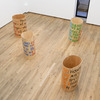
|
Taylor Davis, installation view, 2012. Photo: Carly Gaebe
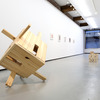
| |
Taylor Davis, Five fingers and a thumb, 2012, milled white pine, 43 x 43 x 43 inches
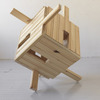
|
Taylor Davis, Five fingers and a thumb, 2012, milled white pine, 43 x 43 x 43 inches

| |
Taylor Davis, Tbox 1, 2012 birch plywood and oil paint, 14 x 16.5 x 16.5 inches

|
Taylor Davis, Tbox 1, 2012 birch plywood and oil paint, 14 x 16.5 x 16.5 inches
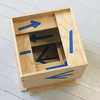
| |
Taylor Davis, this pictur, 2012, watercolor on paper, 18.375 x 14.5 inches
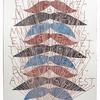
|
Taylor Davis, mustache composition #1, 2012, collage on gessoed wool, 17.75 x 14.25 inches
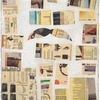
| |
Taylor Davis, SOME HAE, 2011, Wacky Wood and oil paint, 46 x 25 x 21 inches
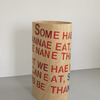
|
Taylor Davis, SOME HAE, 2011, Wacky Wood and oil paint, 46 x 25 x 21 inches

| |
Taylor Davis, BECAUSE I, 2011, oil paint and Wacky Wood, 45 x 27 x 27 inches
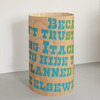
|
Taylor Davis, BECAUSE I, 2011, Wacky Wood and oil paint, 45 x 27 x 27 inches
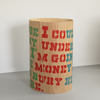
| |
| Anselm Berrigan, "Because Reading is a Physical Act" |
 DOWNLOAD DOWNLOAD |
|
|
|
|
|
|
TAYLOR DAVIS
|
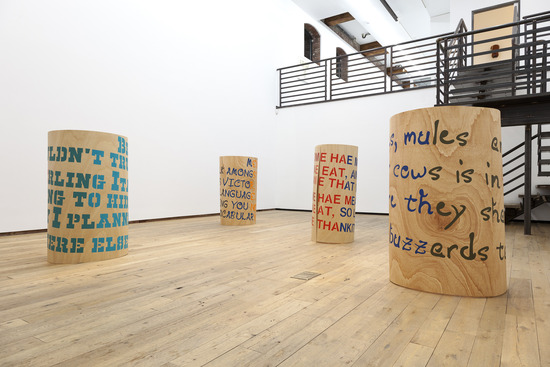
|
IMAGE: Taylor Davis, installation view, 2012.
Photo: Carly Gaebe |
 HI-RES HI-RES |  |
 |
|
On View: April 5 — May 13, 2012
Reception: April 5, 2012 6-8pm |
 DOWNLOAD PRESS RELEASE AS PDF DOWNLOAD PRESS RELEASE AS PDF
| DODGEgallery is pleased to present new work by Taylor Davis. This is the artist’s first solo exhibition at the gallery. The exhibition includes sculpture, drawing, and painting.
For Davis, looking is not passive. Through material, language and form Davis makes evident the consequence of looking, ultimately relying on one’s desire to know to set the collaboration between object and viewer in motion. Davis’ work carefully and sometimes playfully denies preconception, and rewards the active viewer with new ways of seeing.
Four free-standing bent wood cylinders each with a sentence or phrase, painted in highly saturated oil paints that spiral down and around the outside surface of the forms, inspire action. Davis writes:
To comprehend the subject of the text, one must read. Reading is different than looking. There’s an end point, a destination, often marked by a period. And there’s someone’s language in your head… With the cylinders, I’m interested in choreographing an experience in which one simultaneously sees, reads, and walks; eye, mind, and body. Colored shapes on an intricately grained surface, words that form a sentence as slowly or quickly as one walks around and around the object. As one moves on to read the next set of words, one literally loses sight of what one just read... This is not a walk and chew gum moment, it’s a proposal that understanding a thing in its entirety is a difficult, if not impossible, endeavor.
Tbox 1, a small double-stacked floor piece is constructed of birch plywood. Open at the top, it has multiple partial shelves that divide the interior space of the form, much like an aperture of a camera. The piece invites the viewer to look inside. The surfaces are marked with what look be painter’s tape torn into strips and shapes that demonstrate the direction of the wood grain. (The “tape” marks are actually stencils of cobalt blue paint.) This way, that way, up, down, Tbox 1, over- demonstrates how Davis’ choice of a wood grain’s pattern and direction affects the viewer’s perception of the built form. In other words, by diagramming the grain, Tbox 1 – a self-named self-assertive smarty pants – is over telling us to look again.
One of several works on paper in the exhibition, men of, is a maddeningly difficult-to-decipher drawing of text and shape. Two sentences are painted over a stack of friendly colored mustache shapes. Davis stilts readability by irregularly changing between capitals and lowercase letters, by negating space breaks, and by allowing the edge of the paper to sever letters from their words. She also paints extended lines from the natural end-points of letters creating an odd webbing that connects the entirety of the text as one interdependent visual form. Davis is activating, simultaneously, looking and reading by drawing language. She is also forcing the action of reading by making the words difficult to decipher yet, still awkwardly readable. Reading the pretentious dictatorial text* as foreground and seeing the colorful and unique mustaches stacked and centered as a reiterating and undermining background, the viewer experiences pattern as form.
* “Men of honor talk amongst themselves Victor, in a special language. I’m addressing you now in that vocabulary.”
* Herman Wouk, Winds of War
|
|
|
| |
|
|
|
| |
|
|